Could the Seattle Seahawks' defense of 2013 be compared with the greatest defenses of all time?
That question was posed to me by my editor in the hallway at NFL Media's Culver City, Calif., office the other day, after I had started working on a piece discussing where the 2013 Broncos' offense ranks historically.
I balked. No way I'd put this Seattle defense up there with the 1976 Steelers, 1985 Bears or 2000 Ravens. And without even looking at the numbers, I knew that Pete Carroll's group -- as dynamic as it is -- was not even going to make the top 10. Uh, right?
Well, the question did bring to mind a more intriguing query: What, exactly, makes a defense one of the premier units in NFL history?
Is it statistical dominance? Maybe, though that doesn't have to be the only criteria. But let's get to that later. First, let's attempt to add some historical context to the discussion, starting with a look at how Seattle stacks up against the top defenses ever in terms of points allowed -- often viewed as the be-all, end-all category for gauging that side of the ball:
» Fewest Points Allowed per Game -- Since AFL-NFL Merger of 1970
1) 1977 Atlanta Falcons: 9.2
2) 1975 Los Angeles Rams: 9.6
3) 1976 Pittsburgh Steelers: 9.9
3) 1971 Minnesota Vikings: 9.9
5) 1971 Baltimore Colts: 10.0
6) 1970 Minnesota Vikings: 10.2
7) 2000 Baltimore Ravens: 10.3
Seattle, which allowed a league-low 14.4 points per game in 2013, is clearly nowhere close to being one of the top defenses in history, at least not in the traditional sense. That said, the game has changed so much in the past few decades; the manner in which defenses play and are judged is being altered seemingly every few years.
For example, from 1970 to 1977, offensive linemen couldn't extend their hands in pass blocking. In 1978, that was reversed, causing -- along with the institution of the 5-yard bump zone for cornerbacks -- a sea change:
» Fewest Points Allowed per Game -- Since 1978
1) 2000 Baltimore Ravens: 10.3
2) 1986 Chicago Bears: 11.7
3) 2000 Tennessee Titans: 11.9
4) 1978 Pittsburgh Steelers: 12.2
5) 2002 Tampa Bay Buccaneers: 12.3
6) 1985 Chicago Bears: 12.4
6) 1978 Denver Broncos: 12.4
Notice the difference in what premier defenses could accomplish statistically. When those rules changes were enacted (the regular season also was expanded from 14 to 16 games that year), offensive numbers soared and points allowed went up. By 1979, teams were slinging the football around the park with abandon, as Dan Fouts became the first quarterback of the decade to throw for 4,000 yards. And with linemen able to actually extend their reach, guys like Coy Bacon stopped racking up absurd sack totals.
Of course, that wasn't the last rule adjustment to affect NFL defenses ...
» Fewest Points Allowed per Game -- Since 2004
1) 2005 Chicago Bears: 12.6
1) 2006 Baltimore Ravens: 12.6
3) 2008 Pittsburgh Steelers: 13.9
4) 2011 Pittsburgh Steelers: 14.2
5) 2011 San Francisco 49ers: 14.3
6) 2013 Seattle Seahawks: 14.4
Why go back to 2004? Because following the Colts' loss to New England in the 2003 AFC Championship Game, Indianapolis general manager Bill Polian bitterly complained that his receivers were grabbed, molested and pushed around. In the ensuing offseason, "illegal contact" was re-emphasized. At any rate, you can see that the "Legion of Boom" is still a ways away from No. 1.
Given the ways the game has changed, one wonders how the Seahawks' secondary would have fared in 2002 -- or 1972, for that matter -- with their talent level being what it is. As noted, all the rule tweaks in the ensuing years clearly have favored offenses. Just look at the upward trend in points scored per team over the past two decades:
» Points per Game per Team -- League Average
1973: 19.5
1983: 21.8
1993: 18.7
2003: 20.8
2013: 23.4
Complicating matters further: The recent wave of player safety rules, as well as the fact that field-goal kickers have about 5 yards more in their legs and are several percentage points more accurate than they were even 20 years ago. In fact, the 42 most accurate kickers of all time were all active in the past decade.
All that together makes up the complete set of circumstances under which this great Seattle unit -- yes, it is definitely a "great" defense -- is playing. Stopping teams from scoring has become harder than ever -- and yet, the 2013 Seahawks were the best in the league at it. To show you how effective they were, here is a list of statistical categories that they stamped with a "No. 1" this season:
» Stats in Which the Seahawks Led the NFL This Season
Points allowed per game: 14.4
Yards allowed per game: 273.6
Passer rating allowed: 63.4
Yards allowed per play: 4.42
Big plays (20-plus yards) allowed: 36
Takeaways: 39
Let's focus on passer rating allowed. Nowadays, several quarterbacks each season will post a passer rating of 100 or better (seven accomplished the feat in 2013), so it's quite impressive for a defense to allow an aggregate passer rating of 63.4. In fact, that's the lowest mark in pro football since 2009. It should be noted that the Seahawks managed to record such a low figure -- and dominate the passing game -- via defensive backs with unique skill sets ...
... which brings us full circle to this question: What makes a defense one of the best in league history?
Here's one possible answer: creating a blueprint for what other defenses in the NFL are trying to do or will be doing.
Seattle has taken some chances schematically and personnel-wise, yet the Seahawks still managed to finish with the top defense in the league. It's one thing to mix up personnel, make bold draft decisions, take other teams' castoffs and play viably; it's a whole other deal to do all that and finish No. 1. Throw in the fact that many organizations want to replicate the Seahawks' plan, and it makes them a premier unit in the broad scope.
It reminds me of Red Miller's "Orange Crush" Broncos in 1977. Yes, they were good during their time, earning Denver's first Super Bowl berth -- but beyond that, they were historically relevant. The Orange Crush defense took a tactic that some teams had tinkered with -- playing the 3-4 -- and did it so well that it was copied across much of the league.
So what is the Seattle formula? Simply put, it is to jam today's large receivers with just-as-large defenders, play sub packages in passing situations to get fresh legs after the quarterback, and have linebackers who are not just one-trick ponies, but who can rush and/or cover well.
The first huge aspect of the state-of-the-new-NFL defense that Carroll and GM John Schneider mastered was acquiring big corners and making them fit, with former defensive coordinator Gus Bradley providing a nice assist. In 2011, the organization drafted a former Stanford wide receiver in Richard Sherman (6-foot-3, 195 pounds) in the fifth round, then helped him develop into the best corner in pro football. That same year, Seattle signed Canadian Football League castoff Brandon Browner, another huge corner (6-4, 221) who became a key piece. When Browner was suspended this season, another big kid, Byron Maxwell (6-1, 207), stepped in and did what the Seahawks' defensive backs do: jam today's dominant, tree-like receivers (Brandon Marshall, Larry Fitzgerald, etc.) at the line.
Seattle's safeties, meanwhile, provide a perfect blend of coverage ability and physicality. Earl Thomas offers the former, while Kam Chancellor brings a load against the run game and over the middle. And don't sleep on the fact that Thomas is the leader of the defense -- that's über important in a day and age when the secondary is the most prominent part of a D.
The front seven is equally dynamic, and different from those featured in defenses 10 years ago. The Seahawks play a typical front four, with a stout run-plugger in Brandon Mebane. However, they routinely spell that group with their "NASCAR" package. It's a sleeker personnel grouping designed to get after quarterbacks with guys who haven't played 40 to 50 snaps, and thus have an easier time running stunts (which require agility).
How important is that, considering the mobility of quarterbacks today? The answer is obvious. And that's not to mention that nearly every player in Seattle's front seven is capable of rushing the passer, as illustrated by middle linebacker Bobby Wagner's unusual season sack total of five.
'ATL Podcast'

The Around The League team hits all the NFL's hottest topics in its award-winning podcast. Join the conversation. **Listen**
On that front, Seattle has mixed and matched better than any team in pro football. Yes, Schneider decided to spend the money to get pieces like Michael Bennett and edge rusher Cliff Avril in free agency. Because the Seahawks don't have a ton invested (yet) at quarterback or on the offense as a whole -- another factor that separates them from many other teams -- they have been able to afford to splurge. And having guys available to rotate in keeps them from having to ask for full-time play from the still-solid Red Bryant or the 32-year-old Chris Clemons, meaning the Seahawks get more out of them.
All this adds up to Seattle having the premier defense in football right now. What about the all-time picture? Well, the Seahawks' long-term impact -- as more front offices around the league try to mimic what they do, and as opposing offenses continue to adjust -- will ultimately determine where this unit belongs in terms of the larger, historical perspective.
Follow Elliot Harrison on Twitter _@HarrisonNFL_.



